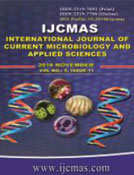


 National Academy of Agricultural Sciences (NAAS)
National Academy of Agricultural Sciences (NAAS)

|
PRINT ISSN : 2319-7692
Online ISSN : 2319-7706 Issues : 12 per year Publisher : Excellent Publishers Email : editorijcmas@gmail.com / submit@ijcmas.com Editor-in-chief: Dr.M.Prakash Index Copernicus ICV 2018: 95.39 NAAS RATING 2020: 5.38 |
Neonatal septicaemia, which is one of the leading cause of neonatal mortality and morbidity in India is characterised by systemic signs and symptoms of infection and accompanied with bacteraemia in first 4 weeks of life. To determine the bacterial spectrum, antimicrobial susceptibility pattern, and the level of contamination associated with the blood culture of the infants with neonatal septicemia in a tertiary level health care setup of North India. In this reterospective-prospective study, 65 blood samples were collected and processed for identification of the causative organism, from the clinically suspected cases of septicemia in neonatal intensive care unit (NICU). Antimicrobial susceptibility pattern of the isolates was obtained by Kirby Bauer disc diffusion method according to the Clinical and Laboratory Standard Institution (CLSI) recommendations. Actual rate of blood culture was observed and the number and nature of contaminants obtained from the blood cultures was also studied. Blood culture reports were positive in 32 (49.23%) cases. Gram-negative septicaemia (59.25%) was encountered more than Gram-positive (40.74%). E.coli (19.23%) was the predominant isolate followed by, Enterobacter spp and Coagulase negative staphylococcus (CoNS) in 15.38% cases each. Best overall sensitivity among Gram-negative isolates was to Colistin (94.44%), Imipenem and Meropenam (83.33%). Gram-positive isolates still showed excellent sensitivity to linezolid and vancomycin . Total rate of blood culture contamination came out to be 7.69% with CoNS being the most common contaminant. A rare pathogen Chrysobacterium indolegens was also isolated from one of the samples but later on it was found to be a contaminant in blood culture. Gram-negative organisms are the leading cause of neonatal septicaemia with E.coli being commonest. Coagulase negative Staphylococci is the predominant isolate among Gram-positive organisms but careful differentiation between the true pathogens and a mere culture contaminant is required since it is the most common contaminant as well. Most of the isolates are becoming resistant to common antibiotics therefore indiscriminate use of the higher end antibiotics like carbapenems and glycopeptides should be restricted.
 |
 |
 |
 |
 |